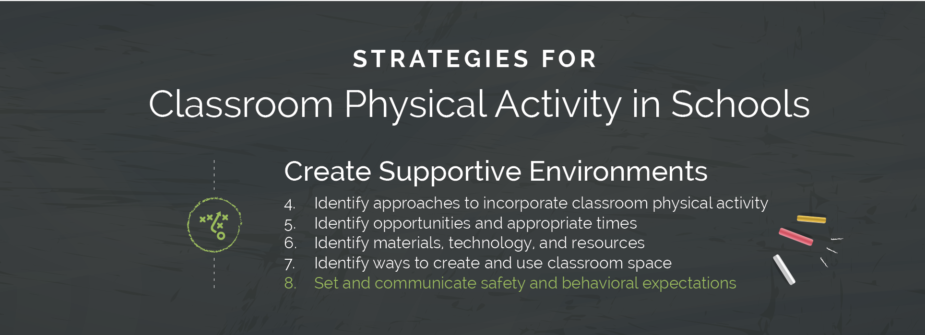Ensure that classroom physical activity is appropriate and safe for all students by setting and communicating safety and behavioral expectations.
Setting safety and behavioral expectations for classroom physical activity is essential to creating a safe and positive learning environment for all students. Many schools communicate behavioral expectations for students through the school’s code of conduct, and expectations for classroom physical activity could be included in this document. Teachers can also individually set expectations for students. These expectations could include participating in the classroom physical activity to the best of their ability; being respectful of different levels of abilities; being aware of their proximity to other students and objects in the classroom; and helping others if needed. Physical education teachers can help identify activities that are developmentally appropriate and safe to use in a limited space and provide guidance on variations and modifications to make physical activities inclusive of all students.
Citations can be found in Strategies for Classroom Physical Activity in Schools.
Key Activities
Put Strategy 8 into practice through the following activities:
✓ Identify what safety and behavioral expectations are in place at the school and classroom levels.
✓ Identify how current safety and behavioral expectations can be used for classroom physical activity.
✓ Determine what supports or professional development needs are required to ensure the safety and inclusion of all students in classroom physical activity.
Note: Supports or professional development needs can be addressed through planning for Strategy 3.
Questions for Consideration
Use the following questions to guide key activities and inspire new ideas:
– What safety and behavioral expectations or policies are in place to ensure the inclusion and well-being (for example, physical, mental, emotional, and social) of all students during classroom physical activity?
– Have these expectations been written down and communicated clearly to students?
– How are these expectations enforced?
– Do teachers receive professional development or training on how to provide physical activity while upholding safety and behavioral expectations and promoting inclusion of all students?
– Can teachers identify and mitigate any potential hazards near areas where students will be physically active (for example, sharp edges or breakable objects)?
– Are teachers able to adapt physical activity for varying levels of comfort and ability?
Resources
Classroom Physical Activity Planning Template
This template (to be used for Strategies 4-8) helps teachers identify physical activities that will work in their classrooms. It also helps teachers plan how they will add physical activity to their classrooms as they develop their lesson plans and units. Considerations for how to promote safety, behavior management, and inclusion for all students are recorded in Column 6.
Expectations to Promote the Safety and Inclusion of All Students
This template provides suggested safety and behavioral expectations and a process for getting input and buy-in from students on expectations.
Help teachers provide physical activity for their students with disabilities – A story from Maryland
Apply the 3 S’s to classroom physical activity – A story from North Dakota and Minnesota
Pair classroom physical activity with alternative activities – A story from Texas
Classroom Physical Activity Planning Template (Springboard to Active Schools)
This template (to be used for Strategies 4-8) helps teachers identify physical activities that will work in their classrooms. It also helps teachers plan how they will add physical activity to their classrooms as they develop their lesson plans and units. Considerations for how to promote safety, behavior management, and inclusion for all students are recorded in Column 6.
Expectations to Promote the Safety and Inclusion of All Students (Springboard to Active Schools)
This template provides suggested safety and behavioral expectations and a process for getting input and buy-in from students on expectations.
Active Academics (Active Academics, Program)
Tips for classroom physical activity behavioral expectations, how to start/stop activities, and how to give instruction.
Activity Bursts in the Classroom (ABC) for Fitness: Teacher Manual (ABC for Fitness)
Page 17 – How to select appropriate intensity levels of physical activity bursts based on student abilities.
Daily Physical Activity in Schools, Grades 1 to 3 (Ontario Ministry of Education, Guide)
- Pages 10-16 – Safety considerations and examples of specific adaptations for students with special needs.
- Page 18 – How to manage physical activity in classrooms.
- Pages 53-58 – Classroom physical activity safety guidelines for facilities, clothing, footwear, and more.
FocusWELL: Physical Activity (Chicago Public Schools, Guide)
Page 33 – Routines, cues, and movements to transition between classroom physical activity and traditional learning.
InPACT 2017: Compendium of Physical Activities (University of Michigan)
- Pages 5-9 – Preventing/treating injuries, asthma, and other special considerations for classroom physical activity.
- Pages 13-24 – Classroom management strategies that address student motivation, teaching/modeling behaviors, troubleshooting, and frequently asked questions.
Move-to-Improve (New York City Department of Education, Program)
Pages v-vi – Tips for creating a positive classroom environment for physical activity (e.g., safety, respect, rules/routines, etc.) and including all students.
Move-to-Improve (New York City Department of Education, Program)
Focused breathing techniques for calming and refocusing students after a physical activity break.
Recess Rocks (Recess Rocks, Program)
Pages 14-15 – Ideas for engaging students with special needs and choosing appropriate music.

